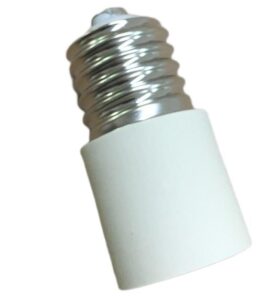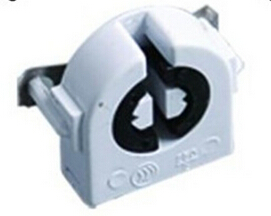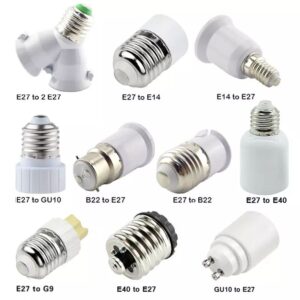Putting a 60W LED bulb in a 40W socket can cause overheating, damage to the fixture, or electrical problems. Use the correct wattage.
If you put a 60W equivalent LED bulb in a 40W socket, it’s usually okay because the LED uses less power, but you need to check to make sure the actual power used is within the limits of the socket.
Let’s talk about how LED bulb wattage impacts sockets and fixtures.

What size LED bulb can I use in a 40-watt fixture?
When using LED bulbs, the most critical factor is the actual wattage consumed rather than the equivalent wattage that represents the bulb’s light output. For a 40-watt fixture, you can safely use an LED bulb that consumes up to 40 watts of power. This is different from incandescent bulbs, where a 40-watt fixture limits the bulb’s brightness directly.
Since LED bulbs are energy-efficient, a bulb labeled as “60W equivalent” may only consume about 8 to 10 watts, which is well within the 40-watt limit of your fixture. Therefore, it’s generally safe to use a higher lumen LED bulb in a 40W-rated fixture as long as the actual wattage doesn’t exceed the fixture’s rating.
How many watts is a 40W LED bulb?
A 40W-equivalent LED bulb typically consumes only about 6 to 8 watts of actual energy. The “40W” label on the bulb refers to the amount of light output equivalent to a 40-watt incandescent bulb, but since LEDs are far more efficient, they use significantly less power to achieve the same brightness.
This low energy consumption makes LED bulbs an excellent choice for energy savings, as they provide the same illumination levels while using a fraction of the electricity. Always check the actual wattage listed on the LED bulb to ensure it falls within your fixture’s wattage rating.

How many watts does a 60-watt LED bulb use?
A 60W-equivalent LED bulb typically consumes between 8 and 12 watts of actual power. Like the 40W LED, this 60W-equivalent produces the same brightness as a traditional 60W incandescent bulb, but with much lower energy usage.
Since the power consumption is so low, many people mistakenly believe that the “equivalent wattage” directly reflects the energy usage. However, it’s the actual wattage—between 8 and 12 watts—that you need to consider when determining if the bulb is safe for use in a fixture rated for a lower wattage, such as 40W.
What is the difference between 40W and 60W?
The key difference between 40W and 60W LED bulbs lies in their light output. A 40W-equivalent LED typically emits around 450 to 500 lumens, while a 60W-equivalent LED bulb emits approximately 800 lumens. This means the 60W LED provides significantly brighter light than the 40W bulb.
While both bulbs use similar amounts of power (roughly 6 to 12 watts), the brightness difference makes 60W bulbs more suitable for larger rooms or spaces that require more illumination, such as kitchens or living rooms. In contrast, 40W LEDs are often used in smaller spaces like bedrooms or accent lighting.

What is the effective wattage of 60W and 40W?
For LED bulbs, “effective wattage” refers to the brightness or light output in comparison to traditional incandescent bulbs. A 60W-equivalent LED bulb generally consumes 8 to 12 watts of actual power, while a 40W-equivalent LED uses around 6 to 8 watts.
In terms of light output, a 60W LED emits about 800 lumens, and a 40W LED provides around 450 lumens. Both consume far less energy than their incandescent counterparts, making LEDs more energy-efficient and suitable for various lighting needs.
Can I use a 15-watt LED in a 40-watt lamp?
Yes, you can safely use a 15-watt LED bulb in a fixture rated for 40 watts. A 15-watt LED bulb provides a much higher brightness than a 15-watt incandescent bulb due to the energy efficiency of LEDs. In fact, a 15W LED bulb could be equivalent to a 100W or even 120W incandescent bulb in terms of light output.
Always check the fixture’s maximum wattage rating to ensure that the actual wattage of the bulb (not the equivalent wattage) does not exceed this limit. A 15W LED will consume far less power than the fixture’s maximum rating of 40W, so it’s perfectly safe.
Can I use a 50-watt bulb in a 40-watt lamp?
Using a 50-watt bulb in a fixture rated for 40 watts is not advisable if the bulb is incandescent or if the LED bulb consumes more than 40 watts. Incandescent bulbs that exceed the fixture’s wattage rating can generate excess heat, which may damage the socket, wiring, or even cause a fire.
However, if the 50W bulb is an LED, the situation changes. A 50W-equivalent LED typically uses around 8 to 10 watts, meaning it falls well below the 40-watt threshold of the fixture. As long as the actual wattage is lower than the fixture’s rating, using a higher lumen LED bulb is safe.

Is 40W or 60W better for bathrooms?
When choosing between a 40W and 60W LED bulb for a bathroom, it depends on the level of brightness you need. Bathrooms generally benefit from brighter lighting due to tasks like shaving, makeup application, or general grooming. Therefore, a 60W-equivalent LED, which emits around 800 lumens, is often better suited for bathrooms.
A 40W-equivalent LED, providing about 450 lumens, may work for smaller bathrooms or secondary lighting. However, for task-oriented spaces like bathrooms, the brighter 60W option is often the preferred choice to ensure adequate illumination for grooming and hygiene.
Match the actual watts of the bulb with the maximum wattage of the lamp socket for safe operation.













